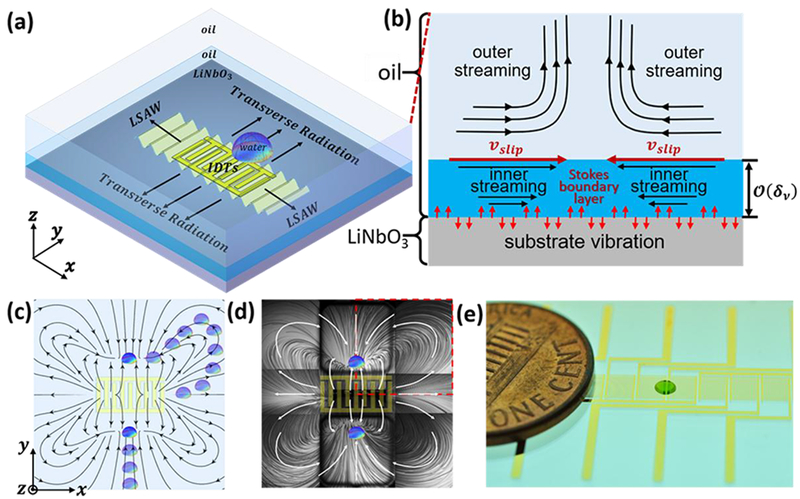Fig. 1.

Illustration of the contactless droplet manipulation via boundary-driven streaming activated by an IDT. (a) Schematic of the mechanism of the acoustic streaming induced by a single IDT-activated vibration on the substrate. The IDT is fabricated on the 128° Y-X cut LiNbO3 substrate and immersed in the 2 mm-thick oil. The IDT, when activated, initiates 3D substrate vibration and thus generates the leaky acoustic wave in the loading oil. The leaky wave induces acoustic streaming in the oil because of the viscous attenuation, and thus it creates two “stagnation points” for trapping objects at the oil-air interface. (b) Schematic of the mechanism of boundary-driven streaming theory. The boundary-driven streaming induced by the substrate vibration mainly confines within the viscous boundary layer. The “outer streaming” (so-called “Rayleigh streaming”) is caused by the “inner streaming” (so-called “Schlichting streaming”) via a steady “slip velocity” at the top of the viscous boundary layer. (c) Simulated acoustic streaming pattern on the oil-air interface showing two symmetryic stagnation points on the two sides of the IDT, where objects floating on the oil would be trapped. Because of the induced acoustic streaming, randomly distributed objects gradually move towards the stagnation points. (d) Stacked image showing the streaming pattern on the oil-air interface. The streaming pattern forms the two stagnation points as indicated by two water droplets. The result shows that the streaming in this domain is roughly axial symmetric about both x-axis and y-axis. As such, a numerical model for this case can be simplified to simulate the area, as depicted by red dashed lines. (e) Image of a device with a 1×10 IDT array for contactless droplet manipulation. The green sphere is a drop of dyed water floating on the loading oil.
